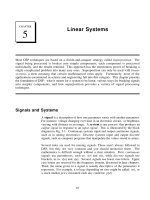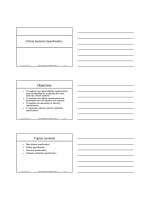Critical Systems
Bạn đang xem bản rút gọn của tài liệu. Xem và tải ngay bản đầy đủ của tài liệu tại đây (87.12 KB, 15 trang )
©Ian Sommerville 2004 Software Engineering, 7th edition. Chapter 3 Slide 1
Critical Systems
©Ian Sommerville 2004 Software Engineering, 7th edition. Chapter 3 Slide 2
Objectives
To explain what is meant by a critical system
where system failure can have severe
human or economic consequence.
To explain four dimensions of dependability -
availability, reliability, safety and security.
To explain that, to achieve dependability,
you need to avoid mistakes, detect and
remove errors and limit damage caused by
failure.
©Ian Sommerville 2004 Software Engineering, 7th edition. Chapter 3 Slide 3
Topics covered
A simple safety-critical system
System dependability
Availability and reliability
Safety
Security
©Ian Sommerville 2004 Software Engineering, 7th edition. Chapter 3 Slide 4
Critical Systems
Safety-critical systems
• Failure results in loss of life, injury or damage to the
environment;
• Chemical plant protection system;
Mission-critical systems
• Failure results in failure of some goal-directed activity;
• Spacecraft navigation system;
Business-critical systems
• Failure results in high economic losses;
• Customer accounting system in a bank;
©Ian Sommerville 2004 Software Engineering, 7th edition. Chapter 3 Slide 5
System dependability
For critical systems, it is usually the case that the
most important system property is the dependability
of the system.
The dependability of a system reflects the user’s
degree of trust in that system. It reflects the extent of
the user’s confidence that it will operate as users
expect and that it will not ‘fail’ in normal use.
Usefulness and trustworthiness are not the same
thing. A system does not have to be trusted to be
useful.
©Ian Sommerville 2004 Software Engineering, 7th edition. Chapter 3 Slide 6
Importance of dependability
Systems that are not dependable and are
unreliable, unsafe or insecure may be
rejected by their users.
The costs of system failure may be very
high.
Undependable systems may cause
information loss with a high consequent
recovery cost.
©Ian Sommerville 2004 Software Engineering, 7th edition. Chapter 3 Slide 7
Development methods for critical systems
The costs of critical system failure are so
high that development methods may be used
that are not cost-effective for other types of
system.
Examples of development methods
• Formal methods of software development
• Static analysis
• External quality assurance
©Ian Sommerville 2004 Software Engineering, 7th edition. Chapter 3 Slide 8
Socio-technical critical systems
Hardware failure
• Hardware fails because of design and
manufacturing errors or because components
have reached the end of their natural life.
Software failure
• Software fails due to errors in its specification,
design or implementation.
Operational failure
• Human operators make mistakes. Now perhaps
the largest single cause of system failures.
©Ian Sommerville 2004 Software Engineering, 7th edition. Chapter 3 Slide 9
A software-controlled insulin pump
Used by diabetics to simulate the function of
the pancreas which manufactures insulin, an
essential hormone that metabolises blood
glucose.
Measures blood glucose (sugar) using a
micro-sensor and computes the insulin dose
required to metabolise the glucose.
©Ian Sommerville 2004 Software Engineering, 7th edition. Chapter 3 Slide 10
Insulin pump organisation
Needle
assembly
Sensor
Display1 Display2
Alarm
Pump Clock
Controller
Power supply
Insulin reservoir
©Ian Sommerville 2004 Software Engineering, 7th edition. Chapter 3 Slide 11
Insulin pump data-flow
Insulin
requirement
computation
Blood sugar
analysis
Blood sugar
sensor
Insulin
delivery
controller
Insulin
pump
Blood
Blood
parameters
Blood sugar
level
Insulin
Pump control
commands
Insulin
requirement
©Ian Sommerville 2004 Software Engineering, 7th edition. Chapter 3 Slide 12
Dependability requirements
The system shall be available to deliver
insulin when required to do so.
The system shall perform reliability and
deliver the correct amount of insulin to
counteract the current level of blood sugar.
The essential safety requirement is that
excessive doses of insulin should never be
delivered as this is potentially life
threatening.
©Ian Sommerville 2004 Software Engineering, 7th edition. Chapter 3 Slide 13
Dependability
The dependability of a system equates to its
trustworthiness.
A dependable system is a system that is
trusted by its users.
Principal dimensions of dependability are:
• Availability;
• Reliability;
• Safety;
• Security
©Ian Sommerville 2004 Software Engineering, 7th edition. Chapter 3 Slide 14
Dimensions of dependability
Dependability
Availability Reliability Security
The ability of the system
to deliver services when
requested
The ability of the system
to deliver services as
specified
The ability of the system
to operate without
catastrophic failure
The ability of the system
to protect itelfagainst
accidental or deliberate
intrusion
Safety
©Ian Sommerville 2004 Software Engineering, 7th edition. Chapter 3 Slide 15
Other dependability properties
Repairability
• Reflects the extent to which the system can be repaired in
the event of a failure
Maintainability
• Reflects the extent to which the system can be adapted to
new requirements;
Survivability
• Reflects the extent to which the system can deliver
services whilst under hostile attack;
Error tolerance
• Reflects the extent to which user input errors can be
avoided and tolerated.
©Ian Sommerville 2004 Software Engineering, 7th edition. Chapter 3 Slide 16
Maintainability
A system attribute that is concerned with the ease of
repairing the system after a failure has been
discovered or changing the system to include new
features
Very important for critical systems as faults are often
introduced into a system because of maintenance
problems
Maintainability is distinct from other dimensions of
dependability because it is a static and not a
dynamic system attribute. I do not cover it in this
course.
©Ian Sommerville 2004 Software Engineering, 7th edition. Chapter 3 Slide 17
Survivability
The ability of a system to continue to deliver
its services to users in the face of deliberate
or accidental attack
This is an increasingly important attribute for
distributed systems whose security can be
compromised
Survivability subsumes the notion of
resilience - the ability of a system to continue
in operation in spite of component failures
©Ian Sommerville 2004 Software Engineering, 7th edition. Chapter 3 Slide 18
Dependability vs performance
Untrustworthy systems may be rejected by their
users
System failure costs may be very high
It is very difficult to tune systems to make them more
dependable
It may be possible to compensate for poor
performance
Untrustworthy systems may cause loss of valuable
information









